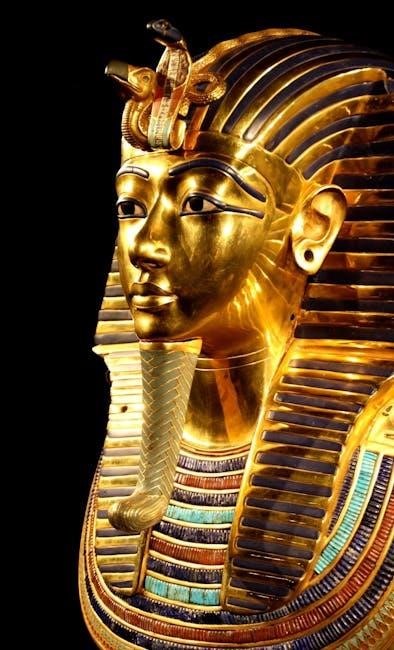Stephen King’s The Boogeyman is a chilling short story exploring grief, trauma, and psychological horror. First published in 1973, it remains a seminal work in King’s bibliography, captivating readers with its haunting themes and terrifying premise.
Overview of “The Boogeyman” by Stephen King
Stephen King’s The Boogeyman is a chilling short story that delves into themes of grief, trauma, and psychological horror. First published in the March 1973 issue of Cavalier magazine, it was later included in King’s 1978 anthology Night Shift. The story follows Lester Billings, a grieving father who recounts the tragic deaths of his three children, blaming the murders on a monstrous entity known as the Boogeyman. King masterfully crafts a narrative that blurs the lines between reality and paranoia, leaving readers questioning whether the Boogeyman is real or a product of Billings’ fractured psyche. This tale has become a classic in horror literature, resonating with readers for its emotional depth and unsettling ambiguity. Its enduring popularity has also led to film adaptations, including a 2023 version, further cementing its place in King’s legacy.

Significance of the Story in King’s Bibliography
The Boogeyman holds a significant place in Stephen King’s bibliography as it exemplifies his ability to weave psychological horror with profound emotional depth. The story, first published in 1973, showcases King’s early mastery of crafting relatable characters and unsettling atmospheres. It explores themes of grief, mental health, and parenting fears, which are common in King’s works but presented here with a unique intensity. The narrative’s ambiguity—leaving readers unsure if the Boogeyman is real or a manifestation of Lester Billings’ guilt—demonstrates King’s innovative storytelling style. This tale has been widely praised for its ability to evoke both fear and empathy, solidifying its reputation as one of King’s most memorable short stories and a cornerstone of his horror legacy.

Background of the Story
The Boogeyman masterfully blends psychological horror with folklore, delving into grief, trauma, and mental health through Lester Billings’ harrowing experience, exemplifying King’s storytelling prowess.
Publication History of “The Boogeyman”
Stephen King’s The Boogeyman was first published in the March 1973 issue of Cavalier magazine. It later appeared in King’s 1978 anthology Night Shift, solidifying its place in his early works. The story gained popularity for its chilling narrative and psychological depth. Over the years, it has been widely circulated in various formats, including digital versions.Fans can now access The Boogeyman in PDF format, making it easily available for modern readers. This accessibility has introduced the tale to new audiences, ensuring its enduring relevance in horror literature. The story’s publication history reflects King’s growing influence in the genre during the 1970s and beyond.

Origins of the Boogeyman Myth in Folklore
The Boogeyman is a mythical figure with roots in global folklore, used to frighten children into behaving. Its origins trace back centuries, evolving across cultures. In some traditions, it is depicted as a monstrous entity hiding in closets or under beds, embodying childhood fears. The term “Boogeyman” varies, with names like “bogeyman” or “buka” in different regions. Folk tales often use this figure to explain unexplained events or to discipline children. Stephen King’s adaptation taps into this universal fear, blending it with psychological horror. The Boogeyman’s enduring presence in folklore highlights its ability to adapt, making it a timeless symbol of terror in literature and popular culture. Its evolution reflects societal fears, ensuring its relevance across generations.
King’s Inspiration for the Story
Stephen King drew inspiration for The Boogeyman from universal childhood fears and folklore. The mythical figure of the Boogeyman, a monster believed to haunt closets, influenced King’s narrative. He explored psychological trauma and grief, crafting a story that blends the supernatural with real-life horrors. King’s interest in the darker aspects of human psychology and the unsettling nature of folklore shaped the tale. The story also reflects King’s ability to adapt myths to modern contexts, making the Boogeyman a symbol of both external terror and internal guilt. His support for the 2023 film adaptation highlights his belief in the story’s enduring power. By weaving folklore with psychological complexity, King created a haunting narrative that resonates deeply with readers.

Plot Summary
Lester Billings recounts the tragic deaths of his children, attributing them to a malevolent entity known as the Boogeyman. His confession reveals a chilling mix of grief, psychological unraveling, and supernatural horror.
Lester Billings is a grieving father who narrates the harrowing tale of his children’s deaths, blaming a monstrous entity known as the Boogeyman. His story, filled with anguish and psychological complexity, explores the blurred lines between reality and delusion. As a father struggling to cope with loss, Lester’s narrative reveals a descent into madness, questioning whether the Boogeyman is real or a manifestation of his guilt. King masterfully crafts Lester’s voice, creating a deeply unsettling account of trauma, bereavement, and the fragility of the human psyche.
The Mysterious Deaths of Billings’ Children
The story unfolds with the tragic deaths of Lester Billings’ three children, each seemingly at the hands of the Boogeyman. The first child dies under mysterious circumstances, dismissed as accidental, while the second death raises suspicions. The third death, however, is undeniably linked to the Boogeyman, leaving Lester shattered. King intricately weaves these events, building a sense of dread and inevitability. The deaths serve as a catalyst for Lester’s psychological unraveling, blurring the lines between reality and his fractured mind. The Boogeyman’s role in these fatalities remains ambiguous, leaving readers questioning whether the entity is real or a product of Lester’s guilt-ridden imagination.
The Role of the Boogeyman in the Closet
The Boogeyman, a monstrous figure lurking in the closet, embodies Lester Billings’ deepest fears and guilt. Its presence symbolizes the darker aspects of his psyche, manifesting as a tangible entity that preys on his children. King uses the closet as a metaphor for the unknown and the terrifying, creating a sense of claustrophobia and inescapable dread. The Boogeyman’s persistent presence haunts Lester, driving him to confront the reality of his children’s deaths and his own complicity. Through this, King explores the theme of repressed emotions and the devastating consequences of unchecked guilt, leaving readers questioning the line between reality and illusion.
Billings’ Mental Breakdown and Confession
Lester Billings’ mental breakdown is a pivotal element of the story, driven by the tragic deaths of his children and his inability to confront the truth. His confession to Dr. Harper reveals his psychological unraveling, as he attributes the killings to the Boogeyman, a monstrous entity he believes lurks in the closet. This delusion serves as a coping mechanism, shielding him from the unbearable guilt of his own responsibility. As the story progresses, Billings’ grip on reality falters, leading to a haunting climax where he finally confronts the Boogeyman, only to realize the horrifying truth. His confession underscores the devastating impact of grief and the fragility of the human mind when faced with unimaginable loss.

Themes and Symbolism

The Boogeyman delves into themes of mental health, parenting fears, and childhood trauma, using the closet as a symbol of hidden terrors and unresolved guilt.
Exploration of Mental Health Issues
Stephen King’s The Boogeyman masterfully explores mental health struggles through Lester Billings’ tragic narrative. The story delves into grief, trauma, and psychological breakdown, as Billings grapples with the deaths of his children. King portrays how unresolved guilt and denial can distort reality, blurring the lines between sanity and delusion. The boogeyman becomes a metaphor for Billings’ inner demons, symbolizing his inability to confront his own failures and emotions. The closet, a seemingly ordinary space, transforms into a symbol of repressed fears and unchecked trauma. King’s portrayal of Billings’ mental unraveling offers a haunting commentary on the fragility of the human psyche, highlighting how unaddressed pain can lead to devastating consequences. This exploration resonates deeply, making The Boogeyman a poignant reflection on mental health and its complexities.
Parenting Fears and Childhood Trauma
Stephen King’s The Boogeyman delves into the profound fears of parenthood and the lasting effects of childhood trauma. Lester Billings’ inability to protect his children from the monstrous entity in the closet symbolizes the universal dread of failing as a parent. The story highlights how the loss of innocence and the reality of vulnerability can shatter familial bonds. King masterfully portrays the psychological toll on children, as they grapple with fear and abandonment. The boogeyman becomes a manifestation of these deeper anxieties, representing the uncontrollable forces that threaten childhood safety. This narrative not only terrifies but also confronts readers with the harsh realities of parenthood and the scars left by unresolved trauma. The 2023 film adaptation further amplifies these themes, making the story a timeless exploration of familial fears and their consequences.
The Symbolism of the Closet as a Source of Fear
The closet in The Boogeyman serves as a powerful symbol of primal fear and the unknown. It represents the dark, hidden spaces where childhood terrors reside, embodying the idea that fear often lurks just out of sight. The closet’s confined, shadowy interior creates a sense of inescapable dread, mirroring the psychological entrapment of its victims. King uses the closet to illustrate how fear can manifest in the most mundane places, transforming them into sources of horror. This symbolism also reflects the idea that fears, like the boogeyman, are often hidden but always present, waiting to emerge. The closet becomes a metaphor for the fragility of safety and the enduring power of childhood nightmares.
The Concept of Guilt and Responsibility
Stephen King’s The Boogeyman delves deeply into the themes of guilt and responsibility, particularly through the character of Lester Billings. Billings’ inability to accept responsibility for the tragic deaths of his children drives the narrative, as he shifts blame to the supernatural entity in the closet. This avoidance of accountability highlights the psychological toll of unresolved guilt, which ultimately leads to Billings’ mental unraveling. The story explores how guilt can consume individuals, forcing them to confront their inner demons. King uses the boogeyman as a metaphor for the pervasive nature of guilt, which haunts its victims and refuses to be silenced. This theme resonates powerfully, inviting readers to reflect on the consequences of evading responsibility and the enduring weight of past actions. The story underscores the idea that true horror often lies within oneself.

Adaptations and Interpretations
Stephen King’s The Boogeyman has been adapted into films, games, and inspired fan theories, captivates audiences with its haunting narrative and timeless horror, ensuring its enduring appeal.
Overview of Film Adaptations of “The Boogeyman”
Stephen King’s The Boogeyman has been adapted into several films, each offering a unique interpretation of the terrifying tale. The 2005 film, directed by Stephen Kay, follows a young man confronting his childhood trauma. In 2023, a new adaptation starring Sophie Thatcher was released, reimagining the story for modern audiences. Both films capture the essence of King’s original narrative, exploring themes of grief, mental health, and the monstrous unknown. The story’s versatility has allowed filmmakers to reinterpret its horror elements while maintaining its psychological depth. These adaptations highlight the enduring appeal of King’s work and its ability to inspire new generations of horror enthusiasts. The Boogeyman remains a chilling testament to the power of fear and the human psyche.
Analysis of the 2023 Film Adaptation
The 2023 film adaptation of The Boogeyman offers a fresh take on Stephen King’s chilling short story, blending psychological horror with modern cinematic techniques. Directed by Rob Savage, the film stars Sophie Thatcher and Chris Messina, focusing on a young woman and her sister grappling with their mother’s death and the monstrous presence haunting them. The movie modernizes the setting while staying true to the original’s themes of grief, trauma, and the blurring of reality. Visual effects bring the Boogeyman to life, emphasizing its terrifying presence. The film received praise for its atmospheric tension and emotional depth, making it a compelling addition to King’s cinematic legacy. It successfully captures the essence of the story while introducing it to a new generation of horror fans.
Other Media Inspired by the Story
Beyond the 2023 film adaptation, The Boogeyman has inspired various forms of media, including video games, stage plays, and even references in popular culture. A 2005 film titled Boogeyman, directed by Stephen Kay, explores similar themes of a monstrous figure haunting a closet, though it is not a direct adaptation of King’s story. Additionally, the Boogeyman has appeared in video games like Five Nights at Freddy’s as a downloadable character, symbolizing childhood fears. The story’s influence is also evident in podcasts and audiobook adaptations, where the chilling narrative is brought to life through sound effects and voice acting. Furthermore, the Boogeyman has been referenced in other Stephen King works, such as It, where the concept of a monster preying on children is revisited. These adaptations and references highlight the enduring impact of King’s tale on popular media and culture.
Fan Theories and Interpretations of the Boogeyman
Fans and analysts have offered diverse interpretations of The Boogeyman, exploring its deeper psychological and symbolic layers. Some believe the monster represents the embodiment of Lester Billings’ guilt and grief over his children’s deaths, while others see it as a metaphor for real-world fears like child abuse or neglect. A popular theory suggests the Boogeyman symbolizes the darker aspects of parenting, where fears of failing or harming one’s children manifest as a terrifying entity. Additionally, some interpret the story as an exploration of mental illness, with the Boogeyman serving as a figment of Billings’ fractured psyche. The ambiguity of whether the Boogeyman is real or imagined has sparked endless debate, leaving readers to ponder the line between reality and delusion.

Availability of “The Boogeyman” in PDF Format
Stephen King’s The Boogeyman is widely available in PDF format through legal channels, including official retailers like Amazon and eBook platforms. Readers can also access it through libraries or purchase it directly from King’s official website. Additionally, various online tools like Foxit Reader and Smallpdf allow users to view and manage the PDF efficiently. Always ensure to download from authorized sources to support the author and respect copyright laws.
Where to Find the PDF Version Legally
Readers seeking a legal PDF version of Stephen King’s The Boogeyman can find it on platforms like Amazon Kindle, Google Books, or Barnes & Noble’s Nook store. Many public libraries offer digital lending services through apps such as OverDrive or Libby, where members can borrow and download the story for free. Additionally, platforms like PDF Drive and Scribd provide access to a wide range of eBooks, including King’s works, with proper licensing. Purchasing directly from the author’s official website or through authorized eBook retailers ensures support for the writer and adherence to copyright laws. Always avoid unverified sources to ensure quality and legality.
Downloading and Reading the Story
Downloading The Boogeyman by Stephen King in PDF format is straightforward for those who prefer digital reading. Once purchased or borrowed from legal sources, the file can be downloaded directly to your device. Readers can use PDF viewer apps like Adobe Acrobat, Foxit Reader, or free alternatives like SumatraPDF to access the story. For a seamless reading experience, consider transferring the file to e-readers like Amazon Kindle or Kobo. Additionally, apps like Calibre allow users to organize and manage their eBook libraries. Ensure your device has sufficient storage and compatible software to open and enjoy the file. This format makes the story portable and easily accessible for reading anytime, anywhere.
Tools for PDF Compression and Viewing
For readers who prefer digital formats, tools like Smallpdf, ILovePDF, and Adobe Acrobat are excellent for compressing and viewing The Boogeyman in PDF. These platforms allow users to reduce file sizes without compromising quality, making it easier to store and share the document. Additionally, PDF viewer software such as Foxit Reader or SumatraPDF provides seamless reading experiences across various devices. Compression tools are particularly useful for ensuring the file doesn’t occupy excessive storage space while maintaining readability. These resources enhance accessibility, enabling fans to enjoy King’s chilling tale on their preferred devices. Using legal and reliable tools also supports authors and publishers, ensuring content is accessed ethically.
Importance of Supporting Authors Through Legal Channels
Supporting authors through legal channels is essential for ensuring the sustainability of creative work. Purchasing or downloading The Boogeyman in PDF format from authorized sources directly benefits Stephen King and the publishing industry. Legal access respects copyright laws, which protect authors’ rights and incentivize the creation of new content. Illegal downloads harm creators by depriving them of rightful earnings, potentially limiting future projects. By choosing legal options, readers contribute to the vitality of literature and ensure that authors like King can continue producing compelling stories. Ethical consumption fosters a healthy creative ecosystem, benefiting both writers and audiences alike. Always prioritize legal channels to support the artists whose work enriches our lives.

Legacy and Cultural Impact
Stephen King’s The Boogeyman has left an indelible mark on horror literature, influencing countless adaptations and cementing its place as a cultural icon of fear and suspense.
Impact of “The Boogeyman” on Horror Literature
Stephen King’s The Boogeyman has profoundly influenced horror literature by redefining psychological terror. Its exploration of trauma, grief, and mental instability set a new standard for the genre. The story’s ability to blend the supernatural with raw human emotion has inspired countless authors and filmmakers. By delving into the darker aspects of the human psyche, King created a narrative that resonates deeply with readers, making it a cornerstone of modern horror. Its influence can be seen in various adaptations and reinterpretations, solidifying its place as a timeless classic in the realm of horror literature.
Comparison with Other King Stories
The Boogeyman stands out among Stephen King’s works for its concise yet impactful storytelling. Like Carrie and It, it explores themes of childhood trauma and psychological distress, but with a unique focus on grief and guilt. While The Shining delves into isolation-induced madness, The Boogeyman examines the mental breakdown of a father grappling with loss. The story’s supernatural elements echo those in The Night Shift, yet its emotional depth rivals King’s more introspective works. This blend of horror and psychological complexity makes The Boogeyman a compelling addition to King’s bibliography, offering fans a fresh perspective on familiar themes while maintaining his signature chilling tone.
Reader Reviews and Ratings of the Story
Readers have consistently praised The Boogeyman for its emotional depth and chilling narrative. With an average rating of 5.7, fans highlight its ability to blend psychological horror with supernatural elements. Many reviewers commend King’s mastery of crafting relatable characters, particularly Lester Billings, whose tragic descent into madness resonates deeply; The story’s haunting conclusion is often cited as one of its most memorable aspects. While some find the tale emotionally challenging due to its themes of grief and guilt, the overwhelming consensus is that it ranks among King’s most unsettling works. For fans of psychological horror, The Boogeyman is a must-read, offering a disturbing exploration of human frailty and the darkness that lurks within.
Academic Analysis of the Story
Academic analysis of The Boogeyman often centers on its exploration of grief, trauma, and psychological horror. Scholars highlight King’s use of the closet as a symbolic space, representing both physical and emotional confinement. The story’s narrative structure, particularly Lester Billings’ unreliable narration, has been studied for its ability to blur the lines between reality and delusion. Researchers also explore the theme of guilt, with Billings’ inability to cope with his children’s deaths serving as a catalyst for his mental breakdown. The boogeyman itself is analyzed as a manifestation of Billings’ inner turmoil, embodying both his grief and his suppressed rage. Academic critiques often praise King’s ability to weave folklore with psychological complexity, creating a tale that resonates on both a primal and intellectual level. This duality has solidified The Boogeyman as a significant work in horror literature.
Stephen King’s The Boogeyman remains a masterful tale of psychological horror, blending folklore with deep emotional turmoil. Its exploration of fear, grief, and mental instability solidifies its enduring legacy.
Final Thoughts on “The Boogeyman”
Stephen King’s The Boogeyman is a masterclass in psychological horror, weaving together folklore and deeply personal trauma. The story’s exploration of grief, mental instability, and the blurred lines between reality and myth leaves a lasting impact on readers. King’s ability to craft a narrative that resonates emotionally while delivering chills solidifies The Boogeyman as a standout piece in his bibliography. The tale’s enduring popularity is a testament to its universal themes, making it a must-read for both horror enthusiasts and fans of King’s work. Its legacy continues to inspire adaptations and interpretations, ensuring its place in the pantheon of horror literature.
Recommendation for Fans of Stephen King
Fans of Stephen King should not miss The Boogeyman, a gripping tale that exemplifies King’s mastery of psychological horror and emotional depth. The story’s exploration of grief, trauma, and the supernatural resonates deeply, making it a standout in King’s bibliography; For those interested in reading the story, the PDF version is widely available through legal channels, ensuring a seamless and high-quality reading experience. Tools like Foxit Reader or Smallpdf can help compress and view the file effortlessly. Whether you’re a longtime fan or new to King’s work, The Boogeyman is a must-read that delivers both chills and profound introspection, showcasing why King remains a titan of horror literature.